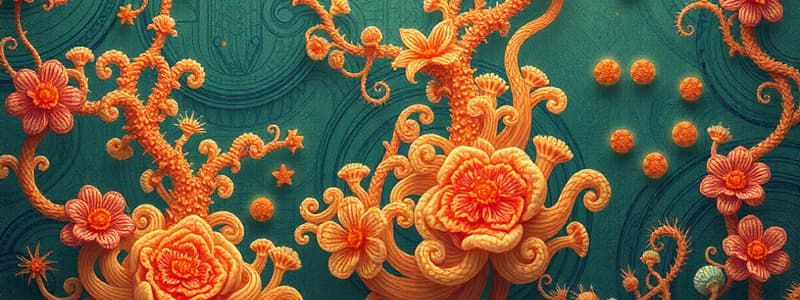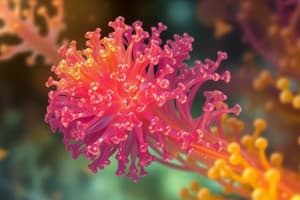Podcast
Questions and Answers
What term describes the process when two gametes are unlike and differ in size?
What term describes the process when two gametes are unlike and differ in size?
- Autogamous
- Heterotrophic
- Homogamous
- Heterogamous (correct)
Which division of algae includes Chlamydomonas and Volvox?
Which division of algae includes Chlamydomonas and Volvox?
- Chlorophyta (correct)
- Euglenophyta
- Phaeophyta
- Rhodophyta
What is the largest size range for protozoa mentioned?
What is the largest size range for protozoa mentioned?
- 20-200 µm
- 500-1000 µm
- 2000 µm / 2 mm (correct)
- 1-4 µm
What is the function of the contractile vacuole in protozoa?
What is the function of the contractile vacuole in protozoa?
Which type of protozoa is considered the most primitive form of animal life?
Which type of protozoa is considered the most primitive form of animal life?
Which structure in protozoa is responsible for enzymatic digestion?
Which structure in protozoa is responsible for enzymatic digestion?
Which division of algae is associated with organisms like Nostoc and Anabaena?
Which division of algae is associated with organisms like Nostoc and Anabaena?
What type of locomotory organ is typically absent in parasitic protozoa?
What type of locomotory organ is typically absent in parasitic protozoa?
What is the primary action of phenolics as disinfectants?
What is the primary action of phenolics as disinfectants?
Which alcohol concentration is commonly used for disinfecting instruments?
Which alcohol concentration is commonly used for disinfecting instruments?
What is a disadvantage of using phenolic disinfectants?
What is a disadvantage of using phenolic disinfectants?
Which of the following metals is used as a germicide in hospital settings?
Which of the following metals is used as a germicide in hospital settings?
What is a common use for quaternary ammonium compounds in disinfection?
What is a common use for quaternary ammonium compounds in disinfection?
What role do halogens like iodine and chlorine play in disinfection?
What role do halogens like iodine and chlorine play in disinfection?
How do heavy metals, such as mercury and silver, function as germicides?
How do heavy metals, such as mercury and silver, function as germicides?
What characteristic differentiates alcohols from other disinfectants?
What characteristic differentiates alcohols from other disinfectants?
What are carotenoids primarily characterized as?
What are carotenoids primarily characterized as?
Which type of motility do swimming algae exhibit?
Which type of motility do swimming algae exhibit?
What type of reproduction involves the conjugation of gametes?
What type of reproduction involves the conjugation of gametes?
What are the motile spores produced in asexual reproduction called?
What are the motile spores produced in asexual reproduction called?
Which algal pigment is characterized as being water-soluble?
Which algal pigment is characterized as being water-soluble?
Which arrangement of flagella is NOT a type mentioned for motile algae?
Which arrangement of flagella is NOT a type mentioned for motile algae?
What is the product of the fusion of gametes during sexual reproduction?
What is the product of the fusion of gametes during sexual reproduction?
Which type of asexual reproduction involves the formation of unicellular spores?
Which type of asexual reproduction involves the formation of unicellular spores?
What is the primary mechanism by which antiviral drugs like acyclovir act?
What is the primary mechanism by which antiviral drugs like acyclovir act?
Which of the following statements about acyclovir is true?
Which of the following statements about acyclovir is true?
Which option describes a challenge associated with antiviral therapy?
Which option describes a challenge associated with antiviral therapy?
What is a common property of antiviral drugs?
What is a common property of antiviral drugs?
Which of the following agents is primarily used for treating Herpes Simplex Virus infections?
Which of the following agents is primarily used for treating Herpes Simplex Virus infections?
What unique characteristic does Valacyclovir possess compared to Acyclovir?
What unique characteristic does Valacyclovir possess compared to Acyclovir?
Inhibiting which enzyme is a key mechanism of action for Acyclovir?
Inhibiting which enzyme is a key mechanism of action for Acyclovir?
Which of the following is true about Ganciclovir?
Which of the following is true about Ganciclovir?
Who were the key figures in the large-scale production of penicillin during World War II?
Who were the key figures in the large-scale production of penicillin during World War II?
What was the first important commercial product produced by aerobic submerged fermentation?
What was the first important commercial product produced by aerobic submerged fermentation?
What mold did Alexander Fleming observe that led to the discovery of penicillin?
What mold did Alexander Fleming observe that led to the discovery of penicillin?
What type of bacterial structure do beta-lactam antibiotics primarily target?
What type of bacterial structure do beta-lactam antibiotics primarily target?
Which of the following antibiotics is classified as a carbapenem?
Which of the following antibiotics is classified as a carbapenem?
What substance is commonly used as a beta-lactamase inhibitor?
What substance is commonly used as a beta-lactamase inhibitor?
Which generation of cephalosporins is Cefepime classified under?
Which generation of cephalosporins is Cefepime classified under?
What is the primary mechanism of action for penicillin?
What is the primary mechanism of action for penicillin?
What was a significant impact of the large-scale production of penicillin during World War II?
What was a significant impact of the large-scale production of penicillin during World War II?
Which antibiotic is NOT a beta-lactam antibiotic?
Which antibiotic is NOT a beta-lactam antibiotic?
Flashcards are hidden until you start studying
Study Notes
Algal Pigments
- Chloroplasts in different algae with similar pigments have similar thylakoid arrangements.
- Chloroplast ultrastructure and pigment chemistry are used to categorize algae.
- There are five types of chlorophyll: a, b, c, d, and e.
- Carotenoids can be carotenes or xanthophylls, with carotenes as the base hydrocarbon.
- Biloproteins are water-soluble pigment, while chlorophylls and carotenoids are lipid-soluble.
- Biloproteins are divided into phycocyanin and phycoerythrin.
- The pigment ratio varies with environmental conditions.
Motility
- Motile algae are called swimming algae with flagella in one, two, or multiple clusters.
- There are three types of flagella: whiplash (smooth and cylindrical), tinsel (hair-like appendages), and ribbon (strap like).
- Non-motile algae are transported by tides, waves, and currents.
Reproduction
- Asexual reproduction occurs through vegetative cell division, creating new colonies.
- Fragments of old multicellular algae can form new filaments.
- Asexual reproduction also involves producing unicellular spores, primarily zoospores in aquatic algae.
- Terrestrial algae generally develop aplanospores, and some can transform into zoospores.
- Sexual reproduction happens through the fusion of gametes, called conjugation.
- The union of gametes forms a zygote.
- Isogamous reproduction occurs when the two gametes are identical and have no sex differentiation.
- Heterogamous reproduction occurs when the gametes differ in size and are considered male and female.
Classification of Algae
- Chlorophyta: Chlamydomonas, Volvox
- Euglenophyta: Euglena
- Pyrrophyta (Dinoflagellates): Dinophysis
- Chrysophyta: Chromulina, Botrydium
- Phaeophyta (Brown algae): Sargassum, Ectocarpus
- Cyanophyta (Blue Green algae): Nostoc, Anabaena
- Rhodophyta (Red algae): Gracillaria,
Economic Importance of Algae
- Algae is an important food source, particularly in Asia.
- Algal extracts are used in many products, including pharmaceuticals, cosmetics, and food.
- Algae can be used to produce biofuels.
- Some types of algae have specific uses, such as agar, used in microbiology and food.
- Some species are used in medicine.
Protozoa
- Protozoa are single-celled mostly microscopic organisms classified under the subkingdom Protozoa of kingdom Protista.
- They are eukaryotic cells with a nucleus and other organelles.
- Protozoan structures include endoplasmic reticulum, Golgi complex, mitochondria, food vacuoles, contractile vacuoles, and nuclei.
Contractile Vacuoles
- Contractile vacuoles are primarily found in free-living aquatic protozoa.
- They are small, rounded vacuoles in the cytoplasm.
- Contractile vacuoles have osmoregulatory function and maintain water balance.
Food Vacuoles
- Food vacuoles are sites for food ingestion and digestion.
- They contain enzymes for breaking down food particles.
Locomotion
- Protozoa possess diverse locomotory organs.
- Flagellates have flagella.
- Ciliates have cilia.
- Pseudopodia for locomotion are present in some species.
- Parasitic forms lack locomotory organs.
Chemical Agents: Phenolics
- Phenols and phenol derivatives (cresols, xylenols, orthophenylphenol) are used as disinfectants.
- They denature proteins and disrupt cell membranes.
- Advantages: tuberculocidal, effective with organic matter, long-lasting activity.
- Disadvantages: disagreeable odor, skin irritation.
Chemical Agents: Alcohols
- Widely used disinfectants and antiseptics.
- Bactericidal and fungicidal, but not sporicidal.
- Effective against some lipid-containing viruses.
- Ethanol and isopropanol at a concentration of 70-80%.
- Mode of action: denaturing proteins and dissolving membrane lipids.
- Effective for disinfecting thermometers and small instruments.
Chemical Agents: Halogens
- Halogens like iodine and chlorine are important antimicrobial agents.
- Iodine is used as a skin antiseptic and kills by oxidizing cell constituents and iodinating cell proteins.
- Higher concentrations can kill spores.
- Iodine is in tincture of iodine (2% iodine in water-ethanol solution) and iodophors (release iodine slowly).
- Applications: preoperative skin degerming, disinfection.
Chemical Agents: Heavy Metals
- Metals like mercury, silver, arsenic, zinc, and copper are used as germicides.
- 1% silver nitrate is used in infants' eyes to prevent ophthalmic gonorrhea.
- Silver sulfadiazine is used on burns.
- Copper sulfate is an algicide.
- Mode of action: combining with proteins, often with sulfhydryl groups, and inactivating them.
- Heavy metals can also precipitate cell proteins.
Chemical Agents: Quaternary Ammonium Compounds
- These are cationic detergents that are effective disinfectants.
Production of Penicillin
- Penicillin was the first important commercial product produced by submerged fermentation.
- It was the first antibiotic manufactured in bulk and is used in semi-synthetic antibiotics.
- Batch culture is used for fermentation.
Alexander Fleming, Howard Florey, and Ernst Chain
- They revolutionized medicine with the large-scale production of penicillin in 1943.
- This discovery saved countless lives during World War II.
Penicillin Notatum
- This mold was observed by Alexander Fleming in 1928 to inhibit Staphylococcus bacteria growth.
- He published his findings in the British Journal of Experimental Pathology.
Mechanism of Antibiotic Action
- Antibiotics affect essential metabolic pathways to inhibit microbial growth.
Summary of Antimicrobial Agents Affecting Cell Wall Synthesis
- Beta-lactam antibiotics
- Penicillins: amoxicillin, ampicillin, dicloxacillin, indanyl carbenicillin, methicillin, nafcillin, oxacillin, penicillin G, penicillin V, piperacillin, ticarcillin.
- Cephalosporins: cefadroxil, cefaclor, cefdinir, cefepime, cefazolin, cefprozil, cefixime, cephalexin, cefuroxime, cefotaxime, cefoxitin, ceftazidime, ceftibuten, ceftizoxime, ceftriaxone.
- Carbapenems: ertapenem, imipenem/cilastatin, meropenem.
- Monobactams: aztreonam.
- Other antibiotics: bacitracin, vancomycin, daptomycin.
- Beta-lactamase inhibitors: clavulanic acid, sulbactam, tazobactam.
Peptidoglycan Synthesis
- Penicillin-binding proteins are critical enzymes for peptidoglycan synthesis.
- Beta-lactam antibiotics bind to these proteins and inhibit cell wall synthesis.
Antiviral Drugs
- They work by:
- Altering the cell's genetic material to prevent virus multiplication (acyclovir).
- Preventing newly formed viruses from leaving the cell (amantadine).
Challenges of Antiviral Therapy
- Rapid virus replication makes it difficult to develop effective antivirals.
- Viruses mutate quickly, rendering drugs ineffective.
- Targeting viruses without harming normal cells is challenging.
Antiviral Drugs: General Properties
- Virustatic: effective only against replicating viruses and not latent viruses.
Agents for Herpes Simplex Virus (HSV) & Varicella-Zoster Virus (VZV) Infections
- Oral agents: acyclovir, valacyclovir, famciclovir.
- Topical agents: acyclovir, docosanol, penciclovir.
- Ophthalmic: trifluridine.
- Intravenous: acyclovir.
Herpes Simplex Viruses (HSV)
- Cause repeated, blister-like lesions on skin, genitals, and mucosal surfaces.
- Some remain latent and can be activated by physical or emotional stress.
- HSV-type 1: non-genital.
- HSV type 2: genital infections.
Acyclovir
- Guanosine analog taken up by virus-infected cells with low host cell toxicity.
- Mechanisms: incorporated into DNA to terminate synthesis, inhibition of herpes virus DNA polymerase.
Acyclovir: Clinical Uses
- Herpes simplex.
- Herpes zoster.
- Chickenpox.
- Epstain-Barr virus.
Ganciclovir and Valganciclovir
- Mechanisms similar to acyclovir.
- Active against all herpes viruses and CMV.
- Low oral bioavailability, given intravenously.
Studying That Suits You
Use AI to generate personalized quizzes and flashcards to suit your learning preferences.



